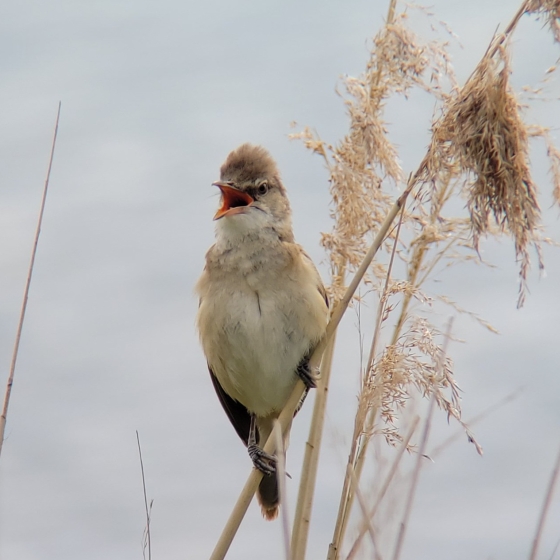Great Reed Warbler

Introduction
Europe's largest warbler is a scarce visitor to our shores, most records falling during May and June.
Spring individuals are often first encountered because of their loud and strident song.

Key Stats
Status and Trends
Conservation Status
Population Size
Population Change
Great Reed Warbler is an annual vagrant to the UK (approximately five records of Great Reed Warbler per year [Bacon et al. 2024]), but is considered to be a potential breeder – individuals have been observed holding territories annually for the past 30 years, but as yet, there have been no pairs or confirmed breeding records [Eaton & the Rare Breeding Birds Panel 2024].
Distribution
This species is a rare vagrant and was recorded during Bird Atlas 2007–11 as shown on the map.
Occupied 10-km squares in UK
2008–11
or view it on Bird Atlas Mapstore.
European Distribution Map
Distribution Change
This vagrant is too rarely reported to map distribution change.
Seasonality
Great Reed Warbler is a rare passage migrant, typically encountered in late spring when males are detected by their loud song.
Weekly pattern of occurrence
The graph shows when the species is present in the UK, with taller bars indicating a higher likelihood of encountering the species in appropriate regions and habitats.

Movement
Britain & Ireland movement
European movements
EuroBirdPortal uses birdwatcher's records, such as those logged in BirdTrack to map the flows of birds as they arrive and depart Europe. See maps for this species here.
The Eurasian-African Migration Atlas shows movements of individual birds ringed or recovered in Europe. See maps for this species here.
Biology
Survival and Longevity
Survival is shown as the proportion of birds surviving from one year to the next and is derived from bird ringing data. It can also be used to estimate how long birds typically live.
Classification, names and codes
Classification and Codes
- Order: Passeriformes
- Family: Acrocephalidae
- Scientific name: Acrocephalus arundinaceus
- Authority: Linnaeus, 1758
- BTO 2-letter code: QW
- BTO 5-letter code: GRRWA
- Euring code number: 12530
Alternate species names
- Catalan: balquer
- Czech: rákosník velký
- Danish: Drosselrørsanger
- Dutch: Grote Karekiet
- Estonian: rästas-roolind
- Finnish: rastaskerttunen
- French: Rousserolle turdoïde
- German: Drosselrohrsänger
- Hungarian: nádirigó
- Icelandic: Reyrsöngvari
- Irish: Mórcheolaire Giolcaí
- Italian: Cannareccione
- Latvian: niedru strazds
- Lithuanian: didžioji krakšle
- Norwegian: Trostesanger
- Polish: trzciniak (zwyczajny)
- Portuguese: rouxinol-grande-dos-caniços
- Slovak: trsteniarik velký
- Slovenian: rakar
- Spanish: Carricero tordal
- Swedish: trastsångare
- Welsh: Telor Mawr y Cyrs
More Evidence
More evidence from Conservation Evidence.com
Partners
Citing BirdFacts
If you wish to cite particular content in this page (e.g. a specific value) it is best to use the original sources as linked in the page. For a more general citation of the whole page please use: BTO (20XX) BirdFacts Species: profiles of birds occurring in the United Kingdom. BTO, Thetford (www.bto.org/birdfacts, accessed on xx/xx/xxxx).

